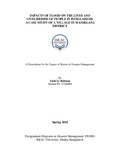Impacts of flood on the lives and livelyhoods of people in Bangladesh: A case study of a village in Manikganj district
Abstract
Water induced disaster including flood accounts over 30% of total losses of lives due
to natural disaster in Bangladesh. On one hand, spatial variation on geography over
short reaches, young and complex geology, and uneven temporal distribution of
rainfall contribute significantly to the occurrences of such water induced hazards,
Exposure to such hazards and vulnerabilities of people mainly due to poverty, and
lack of well preparedness explain the escalating loss of lives and property. The
present comprehensive study investigates the impacts of flood on the life and
livelihoods of the affected area.
The objectives of the study are to assess the situation, the history, the causes,
aggravating factors, extent and effects of the flood, to document the hazard and
vulnerability, and various capacities of the community; to study the local knowledge,
practices and beliefs in the community; to formulate community based plans for flood
mitigation and flood disaster risk reduction. Findings of this phase of study are aimed
to be used as input to second phase when a broader framework of community impacts
analysis conducted. The study found that there are several causes of flood hazards.
They are: construction of infrastructure such as roads, culverts. Without assessing the
monsoon flood, narrow drainage capacity of the haphazard channel excavation for
irrigation due to the absence of proper irrigation canal system, and poor drainage due
to dense settlements.
Flood is found to be a recurrent phenomenon in the study area. In 2000 and 2004
floods have made some devastating impact on the study area. These flood events were
unique in a sense that the floods were mainly due to the heavy precipitation in the
Padma belt. The flood has damaged the physical infrastructures like houses, schools,
sub‐health post, hand pumps, culvert etc. as well as productive agriculture land, and
livestock. Floods have caused difficulty in mobility, increased risk for living at
houses, trends of fear and trauma, and erosion of social assets such as neighborhood,
brotherhood and strong bondage of kinship. Likewise, damage of stored grain and
spread of water borne diseases are other distresses. Increased health hazards,
increased investment in treatment and farming, increase in price of seed, less return
from animal husbandry, poor performance of social institutions, changes in cropping
pattern and reduction in the crop production are immediate impacts of flood on the
livelihood of farmers.
Flood forecasting, early warning system and community based flood management
save many lives and properties. People shared with me some of the indicators that
forecast flood and those indicators are: position of the cloud in the sky, extent of
rainfall in upper catchments and char area, mobility of ants, abnormal fly bite,
abnormal crying/voices of animals and birds, intensity of thunderstorm and wind,
position of stars, and magnitude of hotness. Strange sounds from river/torrents,
muddy smell in the water, rising level of water flow are some indicators perceived as
early warning of flood.

